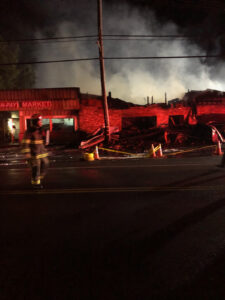Mold is unsightly and can cause a number of health problems. Some studies suggest that prolonged exposure to mold can affect one’s ability to concentrate and focus. It feeds on organic material including wood and sheetrock, causing structural damage.
Mold can spread through the vents in a home. Mold spores are lightweight and can easily become airborne. Once mold spores enter your HVAC system, your ducts can distribute them throughout your house.
Poor ventilation or leaks can lead to mold growth in your air ducts. If you have mold in your home, hire a professional to perform mold remediation in Petaluma. Professional mold remediation addresses the root causes of mold problems, rather than their symptoms.
Here are some signs mold is growing in your vents.
Musty or Moldy Smell
One of the most obvious signs you have mold in your vents is a persistent musty or earthy smell that occurs when you switch on your air conditioning or heating system. This odor can sometimes be localized to specific areas of a home, but it often emanates from vents themselves.
Visible Mold Growth
Although it can be challenging to spot mold inside your ducts, you might notice signs of mold growth such as black, green or white specks around your vent covers, in the ducts, or in the areas around the HVAC system.
You get Sick Too Often
Exposure to a large amount of mold spores can cause health problems, particularly in people with allergies, asthma, or immune disorders. Some common symptoms of mold exposure include persistent coughing, sneezing, a sore throat, nasal congestion, eye irritation, skin irritation, and respiratory problems. If these symptoms only appear when you’re at home, you may have mold in your vents.
Humidity Issues
High humidity levels can encourage mold growth. If your home feels unusually humid or you notice condensation on or around your vents, you may have a mold problem on your hands.
Water Damage or Leaks
If your HVAC system was exposed to water and has incurred water damage, mold may be growing in your ducts. When inspecting your HVAC, watch out for signs of water damage such as water stains and leaks.
Deterioration in Indoor Air Quality
If indoor air quality has deteriorated or the air in your home is stale, mold may be growing in your vents.
Airflow Problems
Sometimes, a blockage in your vents caused by mold growth can reduce airflow. If certain rooms or areas in your home are not receiving adequate air from your vents and feel stuffy, there is a possibility that mold is growing in your vents.
What to do if Mold is Growing in Your Vents?
If you suspect mold in your HVAC system or vents, address the problem promptly to prevent mold spores from spreading throughout your home. Here are some steps you can take
Identify the Extent of the Problem
Determine how extensive the mold problem is. Sometimes, what appears to be mold can be dust or dirt accumulation. If you are sure it’s mold, determine whether it’s isolated to a small area or has spread to different parts of your HVAC system.
Consult Professionals
Mold remediation in Petaluma requires skills, and is hence, best left to the experts. Whether mold is growing in your vents or your rooms, consult a mold remediation specialist. Professionals use advanced mold remediation equipment and are equipped to safely and effectively remove all types of mold. They address underlying causes of mold growth including moisture issues to prevent mold from coming back.
Cleaning Small Areas
If you notice a small patch of mold on your vents, clean it using a mixture of water and detergent. Do not use bleach to clean your HVAC system as it can cause damage to the components of the system and release toxic fumes. After cleaning your vents, dry out the area.
Change Filters
Replace your HVAC filters, as contaminated filters can circulate mold spores through your home. Consider switching to an HVAC filter with a MERV rating of 8 capable of capturing pollen, mold spores, and other airborne particles.
Inspect and Clean Ductwork
If mold is growing in your ductwork, consider having an expert clean your ducts. Look for a professional with experience of treating mold in HVAC systems. Make sure the mold remediation specialist takes all necessary measures to prevent any damage to ducts.
Control Humidity in Your Home
To discourage mold growth, keep relative humidity levels between 30% and 50%. If necessary, use a humidifier.
Consider Professional Testing
If you’re unsure about the extent of mold contamination or if mold comes back after mold remediation in Petaluma, consider hiring a professional to test for mold. Mold testing can help find hidden mold. The professional can recommend specific remediation strategies based on their findings.
Tips to Prevent Mold Growth in Vents
Here are some simple, yet effective ways to keep mold out of your HVAC system.
Stay on top of HVAC Maintenance
Have your heating, ventilation, and air conditioning system inspected and serviced by a professional at least once a year. During an HVAC maintenance session, your HVAC contractor checks for leaks, cleans ducts, and changes filters to prevent dust and mold spores from circulating.
Use High-Quality Air Filters
Invest in high-efficiency particulate air filters. HEPA filters are capable of trapping mold spores and other allergens. Remember to replace your filters according to the manufacturer’s recommendations.
Insulate Ducts
Condensation is a leading cause of mold growth. Insulate your ducts, especially the ones in your crawl space to prevent condensation.
Clean and Dry Wet Areas Immediately
If your vents or any part of your HVAC system gets wet, dry it within 24-48 hours to prevent mold growth. Have a professional inspect your HVAC after a flood to ensure water hasn’t entered your ducts.
West Coast Fire & Water is a leading mold remediation company in Petaluma. We take the guesswork out of mold remediation. To consult one of our mold remediation experts, call 707-462-5326.



